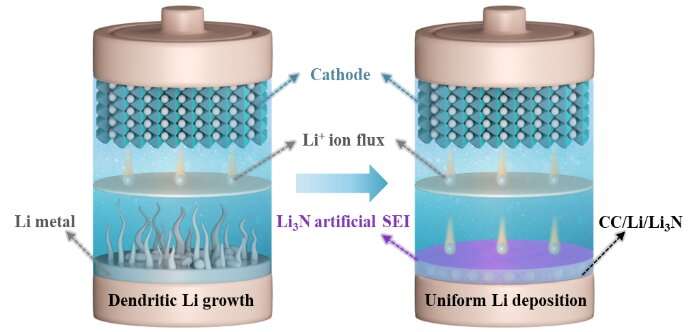Using a lithium nitride gradient in 3D carbon-based lithium anodes for highly stable lithium metal batteries

Recently, Weimin Chen and Faquan Yu from the Wuhan Institute of Technology and Liang Wang from the Chongqing Institute of Green and Intelligent Technology published a manuscript titled "In situ generation of Li3N concentration gradient in 3D carbon-based lithium anodes towards highly-stable lithium metal batteries" in the Journal of Energy Chemistry.
Because of the rapid advancements in portable electronic products, electric vehicles, and clean energy storage devices, developing rechargeable batteries with high energy storage capability and long life has become urgent. Lithium is one of the most promising anode materials for next-generation energy storage systems owing to its high mass-specific capacity (3860 mAhg-1) and low electrochemical potential (−3.04 V) compared with the standard hydrogen electrode.
However, the electrochemical instability and hostless nature of lithium cause uncontrolled dendrite propagation and infinite volume expansion during the lithium plating/stripping process, resulting in the consumption of non-replenishable electrolytes and the internal short-circuit; consequently, the practical applications of lithium metal anodes (LMAs) are impeded.
Here, a three-dimensional (3D) lithium anode with Li3N gradient was fabricated in situ on a carbon-based framework by using the thermal diffusion method (denoted as CC/Li/Li3N). Density functional theory calculations showed that the energy barrier of Li+ diffusion on the Li3N layer was nearly 20 times lower than that on the Li surface, revealing that Li3N can facilitate efficient Li+ diffusion and withstand high current density during the Li plating/stripping process.
In situ optical microscopy further confirmed that Li3N can effectively enable Li+ to pass through the electrode/electrolyte interface and achieve consistent dendritic-free growth under high current density. When assembled with a LiFePO4 cathode, the complete cells showed excellent cycling stability and high capacity retention in liquid-electrolyte-based batteries and solid-state cells, demonstrating the promising commercial universality of the CC/Li/Li3N anode.
More information: Wenzhu Cao et al, In situ generation of Li3N concentration gradient in 3D carbon-based lithium anodes towards highly-stable lithium metal batteries, Journal of Energy Chemistry (2022). DOI: 10.1016/j.jechem.2022.09.025
Provided by Chinese Academy of Sciences




















